DMA Email Council: How to Use Data Collection to Reduce Advertising Spend
02 Dec 2020
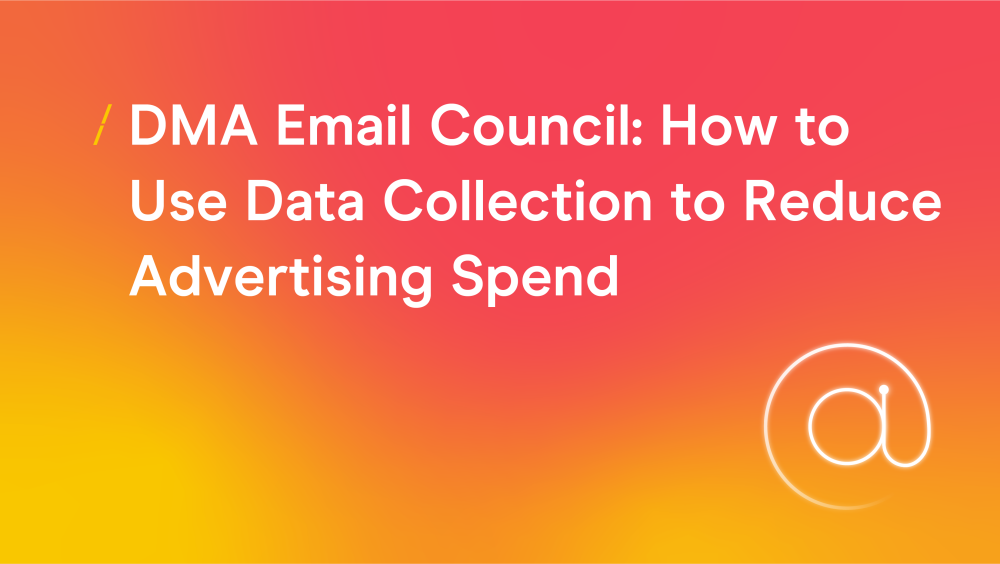
This article is written by Suzanna Chaplin who is part of the Email Council and the Legal and Deliverability Hub.
Since lockdown has all or most of your activity moved online?
Without a shopfront how do you keep bringing people back to your store, without spending millions on advertising?
The most effective, and most simple solution is to build your email newsletter database. The more people you have on your email database, the more people you can reach out to and talk about what exciting products you have in, what events you are doing or launches are happening.
You can build up your database, via paid advertising campaigns, where a cost of acquiring an email address can range from 20p to £1.50 and you can also optimise your website to ensure anyone visiting you are capturing, to talk to later and bring back.
Below is a guide to how best to do this.
According to Campaign Monitor, more people are opening email during the COVID-19 pandemic than ever before.
Collecting somebody’s email address can become your most valuable tool to start a conversation and continuously engage with them, learn about what makes them tick and invite them back in. The best thing about it is that you own the conversation, so you don’t have to pay Facebook, TikTok, Google or someone else for the privilege of reaching them.
How do you go about acquiring email addresses?
- Add a banner to your home page for data collection
This can take a few different formats, including a popover form, which appears either straight after they land on the website or after a set time.
When setting up a popover, you will need to consider the following:
- Dupe and frequency rule: If somebody exits the banner and doesn’t sign up, how often do you show it to them in a set period e.g. a maximum of 2 times in 30 days. I would not show it to them on every visit but don’t discount them, they may need to get to know you more.
- What pages: Will it just be on the home page or do you want this to pop up on the product pages. If you are adding an incentive to the signup, you may want it to pop up on the product page, but the wording may vary if they have already exited it.
- The experience on mobile, where they can often be hard to exit!
An example here:
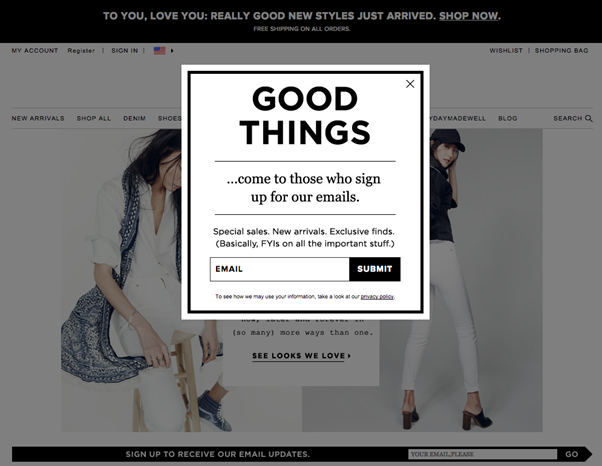
The next type you may want to consider is a floating bar, which can always sit along the top/bottom or can be exited if the user wishes. In the example above, the site has both.
The advantage of the floating bar is that it is always a presence and less intrusive but as a result can be missed and you have less space to add text.
A take on the floating bar is the banner, which starts as hidden but when you start to scroll it expands down to display more information.

Another non-intrusive signup form is a floating box. This option gives you more space for text but does not stop the user from carrying on using the website. It is similar to a live chat pop up box and an example is below.
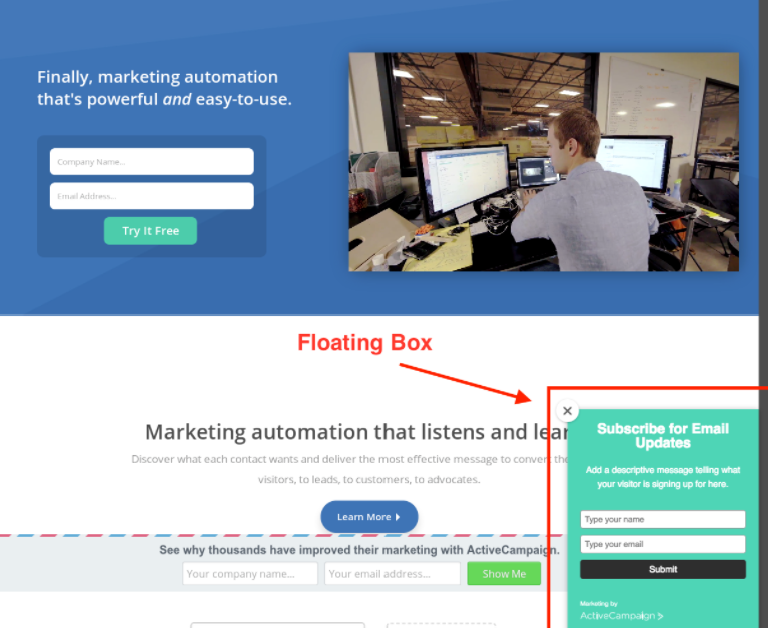
When using a floating box, you need to consider whether it stays present until the user exits it.
The last type is an embedded form, where it is built into the page. This is ideal when your business is built around lead generation but if not, this takes up vital real estate. You could, of course, have a landing page on the site to data collection, which I would recommend. But you would still need to signpost this somewhere on the home page, ideally with one of the recommended formats above.
Here are some great stats on what is the most effective: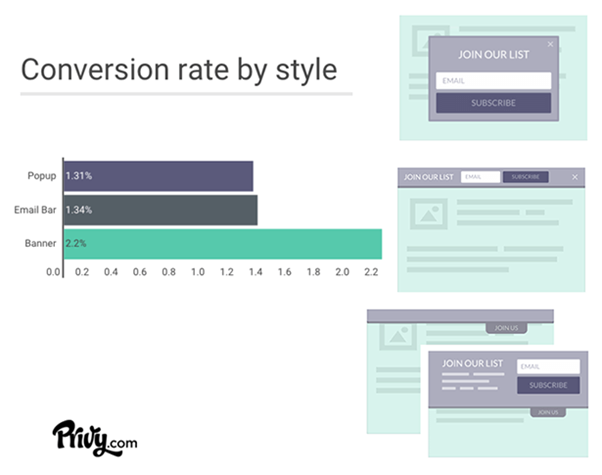
1) The data collected
The more you know about someone, the more relevant your targeting will be and the more likely they are to buy from you. Therefore, you should get as much information from them as possible. However, the more information you ask from a user, the less likely they are to give you their details. It is a very fine balance between gathering what is relevant to you to increase performance and what will not decrease your conversion rates on the form.
I would advise collecting as little information as possible on the first instance but being smart about what you collect and adding to it over time.
For instance, collect name, email, and date of birth. Against date of birth, state it so you can send them a birthday treat. By doing this, you already, created some forward value, that on their birthday, you will send them a birthday gift – this could be 25% discount voucher for them and ten of their friends (secures you more sales) or free next day delivery for 3 months for them and ten friends (builds habits). From the date of birth, you will get age which is useful for your profiling.
I would avoid gender, if you are a shop, you can easily people this up from what they browse.
If you need country, think about whether you get this from the IP address they are browsing from or if they selected the “UK” website.
If you want additional insight, send them a survey within your welcome journey and incentivize this with a prize, e.g. anyone who completes the survey will be entered into a prize draw to win a £250 voucher or give everyone a discount code. Or add a page 2, after you have grabbed the email address, where they can enter additional information but make the first form short and sweet.
Remember data is king – the more you know about someone the better you can target them and then the more efficient you can make your future acquisition, as you will know who your best customers are and find more of these people.
2) The Incentive
Some people will love your brand and give their data freely but for the majority, they are expecting an exchange.
The ICO explains how incentives can be used while still gathering consent.
So, what is the best incentive?
- The discount code. Every retailer’s favourite and every consumer favourite ONLY IF THEY ARE ABOUT TO PURCHASE. If your goal is to build up your database and start a conversation, well the discount code, is not the best tool. The discount code, is great on a page where they are adding items to basket and you are trying to nudge them along but if it’s their first visit and their propensity to buy is low and you know your items are considered purchases and often a customer comes back multiple times before purchasing, consider another incentive.
But if it’s right for you, think about how much, we have seen in data that the sweet spot is 15-30%.
The average conversion on a discount code tends to be 5-10%
- The competition. Conversion rate wise, a competition still outperforms any other incentive. But if you are worried about competition hunters, ensure the prize is relevant to your audience e.g. vouchers for your brand and follow up with a good welcome journey to help educate them on your brand and convert them into customers.
Prizes don’t need to be huge £150-500 is fine.
The average conversion rate tends to be 40-75%.
- The value exchange. This relies on content and can come in the form of a free guide e.g. free fitness guide. This can be a low-cost format, as you can create a PDF which can be downloadable and is great if you can utilise someone well-known or ride on a trend.
The average conversion rate is 15-30%
- Free sample. This works well and if you have the money to do is a great strategy but is expensive, as involves you posting out the samples and means you need enough for every single person who signs up.
The average conversion rate is 20-50%.
3) Timing
When is the best time to display the banner? The answer is whenever it is likely to get the highest conversion rate!
This may be you have more than one banner with slightly different incentives, for instance on a product page, having a banner which floats along the top saying sign up now and get 10% off or as they go to click on a product category a pop-over comes ups. Privy found that they were 25 times more likely to act on it if it was triggered by their interaction with the site, rather than time.
Or perhaps as they exit the site, you have a pop-up coming up saying you sorry to see them go and here is a leaving gift.
4) Copy and styling
Short and sweet but make it personal and put yourself in their shoes. It’s not about you, what does it give to them to sign up. Also, remember to make them smile or laugh.
Things that do work is scarcity, shorter copy and bullet points, images and the call to action needs to look like a button and be in a contrasting colour.
5) Opt-in
For email marketing in the UK, you need to refer to PECR and GDPR.
You need one of two types of permission:
- Consent
- Marketing to customers on an opt-out basis.
Electronic/Email Marketing in the UK and Europe needs one of two types of permission.
This is fully explained by the ICO here.
Here is an overview of how this may apply in practice
- Consent
- Marketing to customers on an opt-out basis
Marketing consent is simple to explain and understand:
- a clear process, setting the correct expectations for the intended marketing
- separate from other terms and conditions
- requires the person to perform an action to indicate and confirm consent – typically achieved with an unticked box, a radio button, or another form of a toggle switch
- Unsubscribe link in each marketing message
- Language is simple and easy to understand
- It is unbundled from consenting to cookies, privacy, and T&Cs
- If you are sharing the data with a third party, is that stated and is there a separate opt-in for this (normally a separate tick box)
On your email opt-in form on the site, you can avoid the tick box, if you are clear what they are signing up to e.g.
"Please enter your email below to receive our email newsletter."
For example, this would work:

A double opt-in is not required but never harms and is often a great way to improve your senders' reputation, so it doesn’t harm to include one but maybe put your value add in there, like the voucher code.
Also, if you do want to share the data with another company, be transparent and get that opt-in the point they sign up by simply adding another tick box, like below:

Summary
- Test different signup boxes to see what style and placement works for you.
- Try different incentives and once you capture their data, nurture them.
- Keep opt-ins short and sweet, you can run a survey after or have a second sign up page.
- Be compliant and don’t try and hide things
- Be authentic and talk in your language and be funny if you want to be.


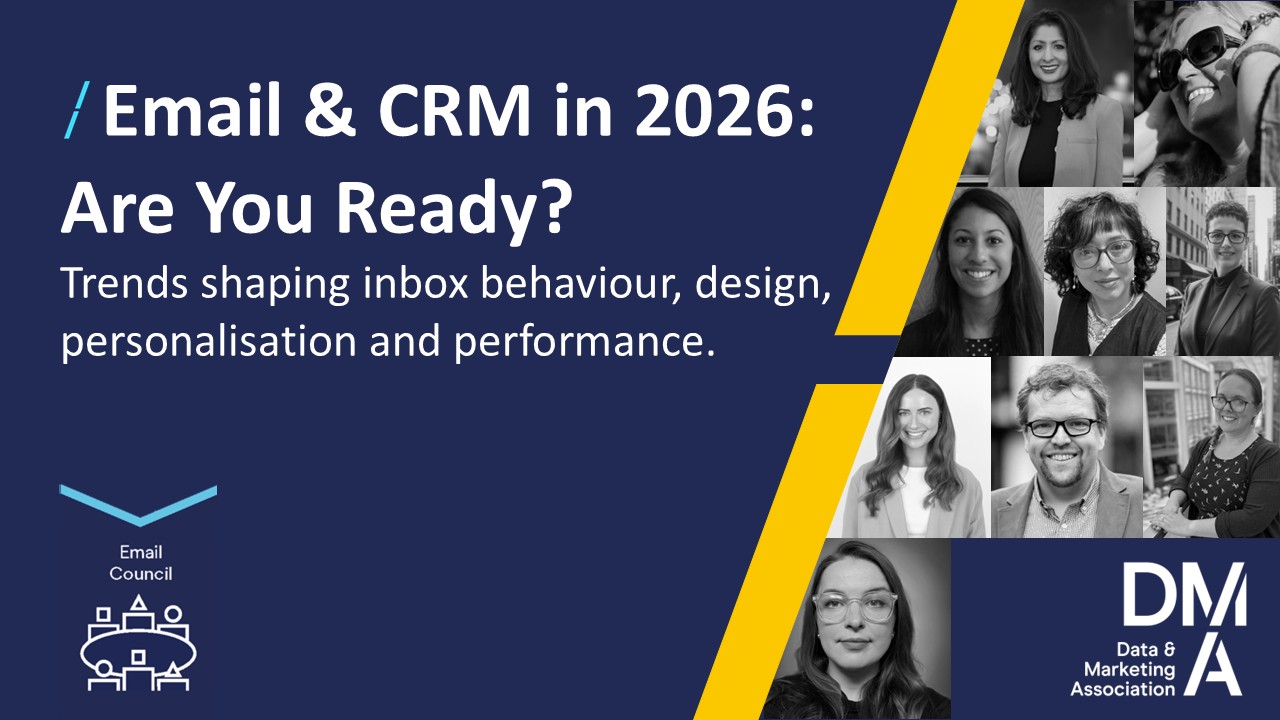

Please login to comment.
Comments